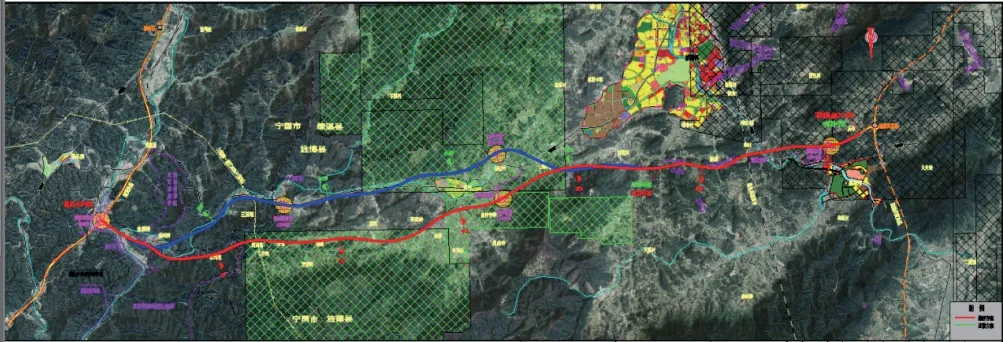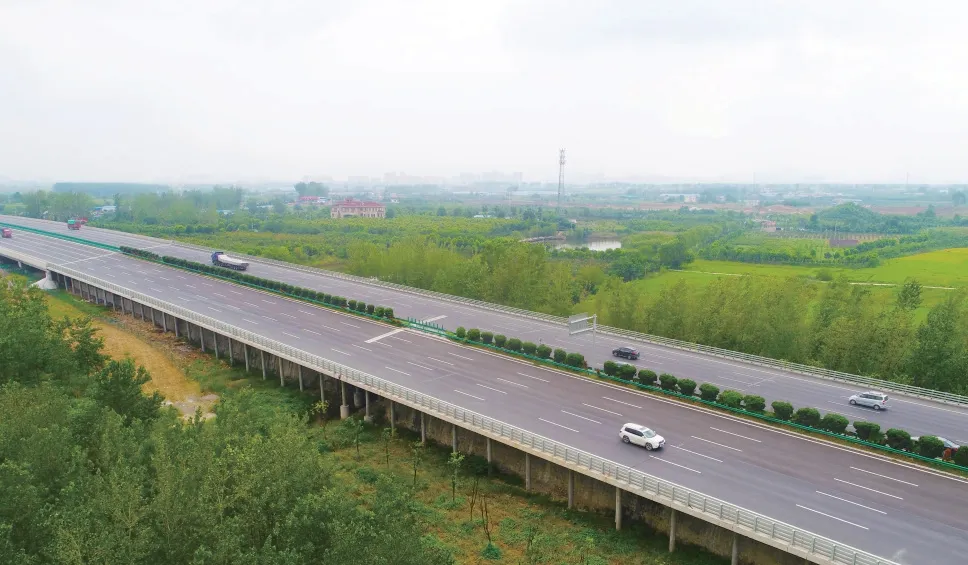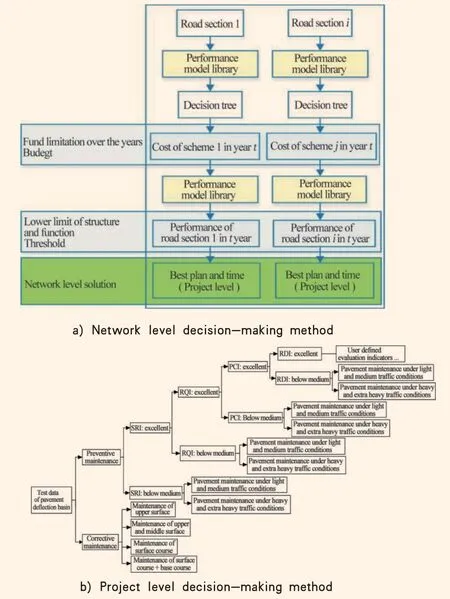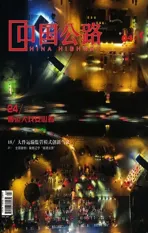Key Technologies and Applications of Carbon Peaking and Carbon Neutralization in Highway Engineering
2023-04-06DahaiYangWenshengShanXiaowuZhouChunhongWang
Dahai Yang Wensheng Shan Xiaowu Zhou Chunhong Wang
(1.Anhui Transport Consulting &Design Institute Co.,Ltd.,Hefei Anhui 230069;2.Research and Development Center on Technology and Equipment for Energy Conservation and Environmental Protection of Highway Transport,Hefei Anhui 230069)
Abstract: Based on the concept of energy conservation and carbon reduction and ecological carbon sequestration,this paper explores the implementation path and key technologies of carbon peaking and carbon neutralization in China's highway engineering field.Based on the perspective of overall planning,science and technology-driven,and saving first,this paper proposes a carbon emission reduction implementation path that focuses on saving and reducing carbon,while taking into account the improvement of energy management and maintenance efficiency and new energy vehicle services.Through land saving,energy saving,material saving and other technologies in the construction process,this paper forms a direct carbon reduction path for highway construction.By making scientific maintenance decisions,this paper improves the new energy vehicle service facilities and other technologies in the service area,forming an indirect carbon reduction path to improve traffic quality and reduce transport energy consumption.Through the restoration of the road ecological environment and the construction of landscape ecology,this paper forms a road ecological carbon removal development path based on carbon sink.As a result,this paper finally forms a low-carbon development mode throughout the whole life cycle of planning,design,construction and operation.
Keywords:Double carbon concept;Green road;Key technologies;application
Since the "13th Five-Year Plan",the green and lowcarbon development of highway projects has achieved remarkable results.A number of green highway demonstration projects have been completed,and the "green" characteristics of the highway construction period are more distinct.However,under the background of "dual carbon",there are still some problems in the construction of green low-carbon roads,such as unclear technology development path and decentralized application of carbon reduction technology,which can not effectively guide the construction of low-carbon roads in China.This paper summarizes the technical application and promotion of highway engineering in green and low-carbon aspects by sorting out the key factors during the construction and operation period of the highway,and proposes the action path of "carbon reduction" and "sink increase" of highway engineering,which can be used for reference to improve the green level of highway infrastructure.
1.Key Technologies of Road Carbon Emission Reduction for Construction
1.1 Road Carbon Reduction Technology Based on Land Saving
1.1.1 Optimization of highway route selection
We try our best to control or reduce the impact of roads on the environment from the source of planning and design,and reduce the occupation of land resources.In addition to focusing on the project scale and investment impact,we have taken avoiding the ecological red line and basic farmland as important factors in the selection of route corridor,listed the damage to the natural environment and the degree of recoverability as the main conditions for comparison and selection,and formulated a "road plan" that takes into account the ecological red line,basic farmland,urban planning,overburden minerals and other impacts as a whole.

Fig1.Schematic Diagram of "One Map of Route Scheme"
1.1.2 Key technology of subgrade thinning and low embankment
The design height,side slope rate and cross section form of subgrade are the main factors affecting subgrade area.Subgrade filling height is closely related to route type,route crossing,minimum filling height,channel form and density.The width of subgrade is mainly affected by highway grade,design speed,engineering geology,protective drainage form and other factors.Therefore,on the premise of meeting the corresponding technical standards,the subgrade section should be reasonably optimized,such as the central partition structure slimming,subgrade side ditch and slope foot protection structure slimming,which can effectively save the occupation of land resources by the highway.

Fig2.Optimization of Subgrade Section Size
1.1.3 Key technologies for land saving of interchange
Interchanges are characterized by large direct land occupation,concentrated land occupation and serious land fragmentation.In recent years,the proportion of land used for interchange has been increasing,so we should include land-saving measures in the main consideration indicators of interchange design.The interworking design should save land resources from two aspects: reducing direct land occupation and segmenting land.We should strictly control the number and spacing of interchanges,increase the level of interchanges,select the appropriate interchange type,determine the appropriate ramp design speed,optimize the ramp alignment,reasonably set the connection lines of interchanges and land use development within the scope of interchanges to reduce the land occupation of interchanges.
1.2 Road Carbon Reduction Technology Based on Energy Saving
1.2.1 Industrial construction technology
Traditional highway construction will bring air pollution,water pollution,dust pollution,etc.,and will also cause certain damage to the ecological environment along the line,with low mechanization and high energy consumption.It is an important measure to reduce carbon emission to adopt the industrial highway construction mode of factory prefabrication and field mechanized installation.
Pile slab road technology is a new low-carbon structural road system,including prefabricated pipe piles and prefabricated reinforced concrete slabs.This technology has innovated the road construction concept.The concept of road structure and industrial construction has realized the new green sustainable development modes of road construction,such as high efficiency,low energy consumption,harmonious ecological environment and "zero interference".Compared with the traditional subgrade scheme,this technology has greatly saved the land acquisition area and has a fast construction speed.


Fig3.Assembly Technology of Pile Slab Subgrade
1.2.2 Green service area construction technology
Many service areas are set up along the expressway,and various methods can be adopted to reduce the resource consumption of buildings.The energy conservation of building structure includes the use of self-temperature regulating phase change materials on the wall,the use of large area windows on the building facade,the use of heat cutoff aluminum alloy profiles for window frames and exterior doors,and the use of low radiation insulating glass for window glass,etc.,to reduce the power consumption of lighting and air conditioning systems;Roof energy conservation includes the use of interlayer between inclined roof and suspended ceiling for summer ventilation and winter insulation,and the use of green roof;Natural ventilation is the main method,and external corridors are used to maintain air flow;Electrical energy conservation includes selecting energy-saving transformer,adopting low-voltage reactive power factor compensation,adopting frequency conversion control for domestic water pump,and setting intelligent lighting control system in public places;Water supply and drainage energy conservation includes the use of intelligent box type pump station for energy saving water supply,watersaving sanitary ware,reclaimed water reuse system,solar energy+air thermal pump hot water system and other technologies.
1.2.3 Green low-carbon pavement construction technology
Warm mixing technology for pavement construction: asphalt pavement construction is usually a hightemperature operation.Asphalt and aggregate are heated from normal temperature to 160℃~180℃,consuming a lot of fuel and generating huge carbon emissions.This technology is to reduce the viscosity of asphalt by adding warm mixing agent or other technical means,so that the mixture has good fluidity at low temperatures to achieve mixing and paving[1].Compared with hot mix asphalt mixture,this technology can save more than 20% of energy consumption and make the maximum emission reduction rate of CO2reach 78%.
Intelligent construction technology: based on the application technology of unmanned construction machinery group,a visual construction management platform is developed.Timely monitor the field construction compaction,thickness,flatness and other information,use 3D scanning to capture the threedimensional information of road surface before and after construction,and obtain intelligent construction parameters with an accuracy of 0.1~10mm.Based on the data of the visual platform,this technology judges the level of the platformIs early warning information,and transmits the construction,supervision and owner according to the level information,so as to facilitate the management of all parties.
Large thickness and full-width pavement construction technology: the subgrade and pavement construction of highway engineering are limited by compaction quality,construction equipment,etc.,which need to be divided into multiple layers,and the construction is slow due to multiple processes;In addition,for the pavement with large road width,multiple pavers are usually used for paving in echelon,and the number of machine shifts is large.This technology adopts single-machine operation,with high utilization rate of construction machinery,reduced construction technology and machinery relocation,low energy consumption and reduced carbon emissions.
1.2.4 Energy-saving technology of tunnel lighting
Lighting facilities will consume a lot of electric energy during tunnel operation.The choice of light source of lighting system has a great impact on energy consumption.LED is known as the fourth-generation lighting source.Compared with high-pressure sodium lamp,it can save more than 60% of energy and have a service life of more than 50000 hours.If LED lamps with different power are used in the entrance,transition,middle and exit sections of the tunnel to replace the traditional high-pressure sodium lamps.At the same time,intelligent lighting technology is used to adjust the lighting brightness in the tunnel according to the actual lighting,regularly collect and store the lighting intensity and traffic flow,upload them to the remote server through the network communication technology,and control the lighting of each section in the tunnel in real time,so as to achieve the dual effect of traffic safety and energy conservation and emission reduction.

Fig4.Method of Maintenance Decision Method
1.3 Road Carbon Reduction Technology Based on Material Saving
1.3.1 Recycling technology of solid waste materials
According to statistics,the construction waste in China has reached 4 billion tons,and the total amount of tailings stockpiled in China has exceeded 10 billion tons,which is still growing every year.In the process of highway maintenance,reconstruction and expansion,a large number of waste materials will also be produced,posing a huge challenge to the environment.The above solid waste materials can use clay,inorganic binder and organic binder as cementing materials,and the subgrade application indicators shall be formulated based on the performance requirements of highway subgrade fillers under different working conditions [2];We use solid waste to replace sand and gravel materials in cement stabilized macadam;We use solid waste materials to replace natural sand,crushed stone and powder in concrete to prepare cement concrete products mixed with solid waste;We have improved the recycling rate of waste resources by increasing the proportion of solid waste in asphalt mixture and preparing asphalt concrete products mixed with solid waste.
1.3.2 Utilization Technology of Tunnel Waste Slag
The construction of mountain roads will produce a large amount of tunnel waste.Tunnel waste will pollute the environment and also cause water and soil loss.A large part of tunnel waste slag is medium to slightly weathered rock mass with high strength,complete structure and good quality.It can be used for subgrade filling and protection,concrete masonry,machine-made sand processing,gravel processing,tunnel lining,opencut tunnel and inverted arch backfilling,etc.It can also be used as high-quality road-building materials after being selected.
2.Key Technologies of Highway Carbon Emission Reduction Based on Operation
2.1 Road Maintenance Decision-Making System Based on Two-Way Carbon Reduction
According to statistic s,8 0% of the carbon emissions during road operation period come from vehicle transpor t.Road quality and traffic efficiency have a significant impact on vehicle fuel consumption.Scientific and reasonable maintenance decision-making is the inherent demand of green and low-carbon highway operation.Road maintenance should reasonably determine the timing of large and medium maintenance in combination with carbon emission indicators to achieve the best time to take the most appropriate maintenance measures for the sections most in need of maintenance,so as to improve the road service level and traffic quality.
2.2 New Energy Vehicle Supporting Basic Services
Motor vehicle exhaust emission is the main source of urban air pollution,accounting for 79% of the total pollutants.New energy vehicles have basically achieved "zero emissions".Therefore,we can build charging facilities in highway service areas,guide the use of new energy vehicles,make full use of clean energy such as solar energy and mechanical energy,and adopt emerging power generation technologies such as photovoltaic power generation,piezoelectric technology and garbage power generation to realize the greening of electricity "sources".
3 Key Technologies of Road Ecological Carbon Sequestration Based on Carbon Sink
Road plant carbon sink[3]refers to the process in which road plants absorb atmospheric carbon dioxide through photosynthesis and fix it in vegetation and soil,thus reducing atmospheric carbon dioxide concentration.Highway area vegetation greening includes slope,middle separation belt,interworking,service area and other areas.As the transition zone between the road and the surrounding natural environment,vegetation greening not only has the function of reducing soil erosion,improving the driving environment and avoiding natural disasters in the road area,but also can absorb CO2,improve the ecological environment in the road area,and enhance the carbon fixation and oxygen release in the road area.
T he main f ac tor s af fec ting plant c ar bon sequestration capacity are plant species,plant quantity,season,etc.According to the natural geographical characteristics,climatic conditions and carbon sequestration mechanism of greening tree species in the region where the highway is located,an evaluation model of road plant carbon sequestration capacity is established.According to the amount of carbon fixation and oxygen release of different greening trees in different periods,SPSS statistical software was used to cluster and classify common trees.Reasonably configure plants,such as fast-growing plants with fast carbon fixation speed and high efficiency in the early stage,slow-growing trees,because of their long life and lasting carbon sink function,the combination of fastgrowing and slow-growing trees can form good and long-term landscape and ecological benefits.Properly increase the proportion of evergreen plants to ensure the effect of carbon fixation and oxygen release in autumn and winter,and achieve the effect of evergreen plant landscape in all seasons.The carbon fixation capacity of arbors is higher than that of shrubs.Taking arbors as upper-layer tree species and reasonably matching small trees and shrubs in the middle layer can form a rich spatial greening layer.The natural type of plant configuration carbon sink is significantly higher than the regular type.Regular planting,such as patterned flower bed planting,requires a large amount of manual pruning and maintenance due to the need for modeling,so carbon sequestration is accompanied by large carbon emissions.Natural landscape,less manual maintenance,relatively low carbon emissions,and more lasting carbon fixation capacity.
4 Conclusion and Prospect
Under the dual carbon concept,highway construction needs to meet the needs of ChinaIs development,change the road construction mode,and select energy-saving materials and equipment.While protecting the ecological environment,we should actively use various technical means to improve the application technology of waste materials,so as to effectively reduce carbon emissions and improve the quality of green development.
(1) Low carbon highway is the embodiment of injecting low carbon concept into the whole process of highway construction and operation.It is the main direction of future development of highway construction industry and environmental resource protection,and is conducive to maximizing environmental protection and optimizing resource allocation.
(2) At present,the recycling technology of solid waste materials has large investment and high recycling cost,resulting in low recycling rate.In the future,it is still necessary to strengthen the research on multiple recycling methods to reduce recycling costs and establish a recycling industry chain system for the whole society.
(3) The standard system of highway green design has not been established,resulting in unsystematic and imperfect new technologies and methods.In the future,we should strengthen summary and research,establish green design specifications and standards as soon as possible,form green road evaluation methods,and promote the healthy and sustainable development of green roads.
